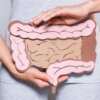
For many people with digestive issues, certain foods may trigger or worsen symptoms.
Gluten is found naturally in a wide range of natural (and processed) foods and in skeptical individuals may contribute to digestive symptoms.
This article will explore the appropriate times to go gluten-free, even if coeliac disease has been ruled out.
What is a gluten-free diet?
A gluten-free diet is considered a therapeutic diet to remove all forms of gluten.
For a long time, a gluten-free diet was only considered for patients with a diagnosis of coeliac disease. However, it has also been found to be helpful in patients with other conditions.
When is a gluten-free diet helpful?
A gluten-free diet is recommended following the diagnosis of Coeliac disease. Coeliac disease is an autoimmune disease characterised by an inflammatory response in the bowel following the ingestion of gluten.
While this is not the same as IBS, it can share some common symptoms such are bloating, diarrhoea and abdominal pain.
Coeliac disease can be higher in certain parts of the world. This is partly due to the amount of gluten consumed as well as genetic factors. In regions such as America, North Africa, the Middle East and India it’s understood to be present in 1-2% of the population. [1]
At present, the only known treatment for coeliac disease is the strict avoidance of gluten-containing foods. This is also referred to as a gluten-free diet. This removes certain grains from the diet.
These include:
- Wheat
- Rye
- Barley
- Kamut
In the vast majority of those with Coeliac disease, a gluten-free diet improves the symptoms and complications of this condition. [2]
A strict gluten-free diet is recommended if Coeliac disease has been diagnosed. This is due to some of the serious complications that can follow if patients with Coeliac disease are left untreated. These complications of untreated Coeliac disease include a 2-4 times risk of non-Hodgkin’s lymphoma and a 30 times risk of developing small intestinal cancer.
A gluten-free diet can also be helpful in some IBS patients. This may be due to the IBS symptoms being caused by non-coeliac gluten sensitivity or an issue with the fibre found in gluten-containing foods. These 2 factors are discussed in more detail below.
Does gluten damage the gut?
There are specific genes that increase the susceptibility of someone developing coeliac disease. In these individuals eating gluten-containing foods leads to an autoimmune process that damages the gut.
This process involves the poorly digested gluten proteins travelling across a damaged gut lining which then triggers the immune response. This immune reaction in the small intestine triggers inflammation which then damages the gut lining.
This damage is evident along the lining of the small intestine. This involved damage to the surface of the gut lining which involved flattening of the villi which can be seen when samples are examined under a microscope. Due to the role the villi play in supporting absorption a reduction or flattening of these can lead to malabsorption which can lead to gut symptoms such as bloating and diarrhoea. [3]
This damage also leads to intestinal permeability which is often referred to as ‘leaky gut’.
The reason for a gluten-free diet is to halt this immune response and to allow the gut to heal and regenerate. [4]
What foods contain gluten?
The only known treatment for Coeliac disease is a strict gluten-free diet. This involves the removal of certain grains as well as products made from those grains.
These include:
- Wheat
- Rye
- Barley
- Kamut
- Triticale
- Spelt
- Durum
- Couscous
- Semolina
- Farina
- Farro
- Einkorn
- Wheat berries
- Bulgur
- Wheat bran
- Wheat starch
- Wheat germ
This also includes the products made from these grains such as:
- Pasta
- Bread
- Cookies
- Granola bars
- Pastries
- Cereals
- Gravies
- Crackers
Gluten-free grains include:
- Teff
- Millet
- Rice
- Maize
- Oats
- Amaranth
- Quinoa
- Buckwheat [5]

What is gluten cross-contamination?
There are many ways someone can be exposed to gluten outside of eating food that naturally contains gluten. This is referred to as cross-contamination and can occur through 2 main means.
Firstly it can happen during the processing of products in factories or storage in warehouses. This is where gluten-containing grains and gluten-free grains come into close contact with gluten accidentally contaminating the gluten-free foods.
It can also happen during the cooking process due to a lack of care in commercial kitchens and restaurants. Practices such as separating gluten-containing and gluten-free grains should be followed as well as the cooking tools used to prepare foods.
The risk of contamination increases when foods are sold in open containers such as in bulk buying practices or displayed and served from buffets.
Non-food sources of gluten exposure have also been identified. These can involve the exposure and ingestion of gluten via means such as:
- Medications
- Supplements
- Toothpaste
- Mouth wash
- Lipstick
This may be in the form of an ingredient or as a coating or contaminant. This may be most relevant when a medication or product is used on an ongoing basis.
For clarity on the gluten-free nature of these products contacting the manufacturer is often advised. Products applied to the skin which includes lotions and shampoos should not be a concern. [6]
What foods to eat on a gluten-free diet?
Even though gluten-containing foods such as bread may be a challenge to remove, there is an extremely wide range of foods that can be consumed on a gluten-free diet.
These include:
- All vegetables
- All fruits
- Unprocessed meats (eg: beef, lamb, chicken)
- Fish (eg: salmon, cod, sardines)
- Gluten-free grains (eg: Amaranth, buckwheat, corn, millet, rice, teff)
- Nuts
- Seeds
- Herbs
- Spices
Bread and pasta often contain gluten, however, there are gluten-free alternatives. For most of my patients, I suggest for the initial period of a gluten-free diet that gluten-free breads a removed also.
This is due to these often being highly processed and containing fibres and preservatives that may contribute to digestive symptoms, thus clouding the response to a gluten-free diet.
What foods to avoid with a gluten-free diet?
Gluten can be found in a range of natural and processed foods.
Gluten-containing grains include:
- Wheat
- Varieties wheat (wheatberries, durum, semolina, spelt, farina, farro, graham)
- Rye
- Barley
- Brewer’s Yeast
Common Foods That Contain Gluten include:
- Pasta
- Couscous, and gnocchi)
- Noodles (ramen, udon, soba (those made with only a percentage of buckwheat flour) chow mein, and egg noodles – rice noodles and mung bean noodles are gluten-free)
- Bread and Pastries
- Baked Goods
- Cereal & Granola
- Beer (unless specifically labelled as gluten-free)
- Brewer’s Yeast
There are additional foods that can contain gluten, however, this does depend on the manufacturer and the production.
These can include; energy bars, chips/fries, processed meats, soups, syrups, and soy sauce.
Who needs a gluten-free diet?
A gluten-free diet may be appropriate for 3 groups of people.
Those with:
- Coeliac disease
- IBS
- Other health conditions
Coeliac disease
A strict gluten-free diet is the only known way to address coeliac disease.
IBS
Patients with IBS may have non-coeliac gluten sensitivity or an issue with the FODMAP fibres also present in many gluten-containing foods.
Other health conditions
Non-coeliac gluten-sensitivity may trigger an inflammatory response which may contribute to symptoms in those with arthritis, thyroid conditions and acne.
Non-Coeliac gluten sensitivity
It is also possible for someone to have a negative coeliac test result, but also have a reaction when eating gluten. This is termed non-coeliac gluten sensitivity.
These individuals experience similar symptoms to those with coeliac disease which are both digestive (bloating, pain, diarrhoea) as well as non-digestive (headache, skin rash, joint pain). However, they have not tested positive for coeliac disease through either a blood test for coeliac disease or an intestinal biopsy. An allergy to wheat also needs to be excluded before this diagnosis is made
It is more likely that those with NCGS can tolerate a small amount of gluten and do not need to stick to a gluten-free diet as strictly as those with diagnosed coeliac disease. Research indicated that a 6–8-week period on a strict free diet may help to improve tolerance to gluten consumed in small amounts. However, this can vary from person to person.
Are there risks to going gluten-free?
From a health perspective, there are no clear risks to going on a gluten-free diet. Especially, if the diet is followed for a short period of time as an initial assessment of how beneficial it may be.
When going on a gluten-free diet, simply removing gluten should not be the only consideration. But a large focus should also be on including a wide range of natural and unprocessed foods. This diversity of foods is beneficial for gut health and overall wellbeing.
How to get started with a gluten-free diet?
Often the best way to start a gluten-free diet is to create a meal plan that can be followed. This may be a 7-day meal plan that can be repeated each week.
Generally, 1 month on a gluten-free diet should provide an indication of how helpful this may be for a specific patient.
During this time, it can be important to factor in any social events or time when travelling. This may require food to be made in advance or for restaurants to be selected based on their gluten-free options.
Frequently Asked Questions
Is a wheat-free diet the same as gluten-free?
While wheat does contain and is most likely the most common source of dietary gluten, a wheat-free diet is not the same as a gluten-free diet.
A gluten-free diet involves the removal of all sources of gluten. This can be with the removal of other gluten-containing grains such as rye and barley as well as processed foods that contain gluten.
Can a gluten-free diet help you lose weight?
For a large percentage of the population of the Western world, there can be a heavy reliance on gluten-containing foods such as bread a pasta. The removal of these foods when following a gluten-free diet may lead to weight loss.
Is a gluten-free diet good for IBS?
A gluten-free diet can be considered in cases of IBS. In the absence of coeliac disease, it may still be possible for the immune system to react to gluten, leading to digestive symptoms.
It’s also possible for there to be a reaction of the FODMAP fibre found in wheat. This is where for many IBS patients, a gluten-free diet is helpful, not because gluten is removed but because certain fibres are eliminated.
References
Accomando S, Cataldo F. The global village of celiac disease. Dig Liver Dis. 2004 Jul;36(7):492-8. doi: 10.1016/j.dld.2004.01.026. PMID: 15285531.
Ciacci C, Cirillo M, Cavallaro R, Mazzacca G. Long-term follow-up of celiac adults on gluten-free diet: prevalence and correlates of intestinal damage. Digestion. 2002;66(3):178-85. doi: 10.1159/000066757. PMID: 12481164.
Bascuñán KA, Vespa MC, Araya M. Celiac disease: understanding the gluten-free diet. Eur J Nutr. 2017 Mar;56(2):449-459. doi: 10.1007/s00394-016-1238-5. Epub 2016 Jun 22. PMID: 27334430.
Duerksen DR, Wilhelm-Boyles C, Parry DM. Intestinal permeability in long-term follow-up of patients with celiac disease on a gluten-free diet. Dig Dis Sci. 2005 Apr;50(4):785-90. doi: 10.1007/s10620-005-2574-0. PMID: 15844719.
See J, Murray JA. Gluten-free diet: the medical and nutrition management of celiac disease. Nutr Clin Pract. 2006 Feb;21(1):1-15. doi: 10.1177/011542650602100101. PMID: 16439765.
Dieterich W, Zopf Y. Gluten and FODMAPS-Sense of a Restriction/When Is Restriction Necessary? Nutrients. 2019 Aug 20;11(8):1957. doi: 10.3390/nu11081957. PMID: 31434299; PMCID: PMC6723650.
History
- Review and updated 6th June 2024 by Martin Cohen






